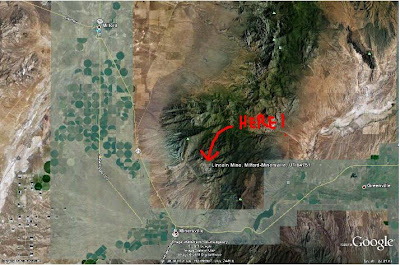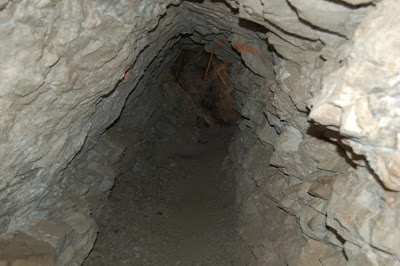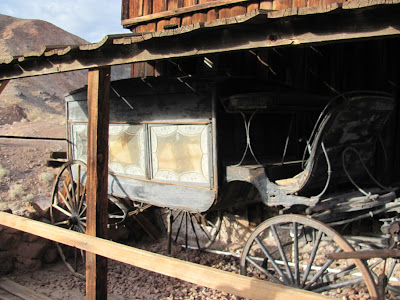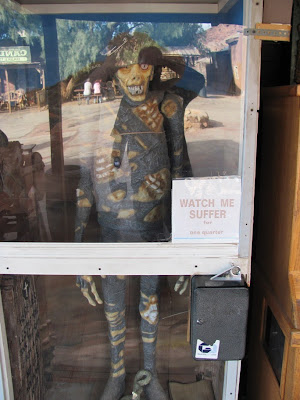Lets look at a mine stooped with history. Something that really enslaves the mind and pro-richens the heart. A mine that has all the rich, lustrous B-vitamins of history that you've come to expect from this blog and at the same time holds back the formation of the dandruff of ignorance! I read most of this paragraph off of a Head and Shoulders bottle. Ahhhh, Head and Shoulders, the perfect cure for writers block. But this post isn't about hair-care products! It's about this mine!

That sir, is the first mine in Utah. Well, kinda. If you pretend that the Spaniards didn't mine anything before the Mormons go here, THEN it's the first mine in Utah. So, in a much more factual way, it's in no way the first mine in Utah. But it is still largely recognized as the first mine in Utah, so let's go with that. We are going to need a little back story to truly appreciate the glory of this mine, so here we go.
Mormons first arrived in Beaver County in 1856 with the intention of doing what they do best; settling and growing stuff and attempting to escape the usual dangers of frontier life. One of the things that early Mormon settlers did not do was work in mines, or even look for mines really. Early church leaders found the prostitute-rich lifestyle of the miner to be somewhat at odds with the chastity-based viewpoint. Likewise, most miners tended to avoid Mormonism with particular vigor for the same reason. But gold heals all wounds, and the miners came anyway.

But the leader of the Mormon church (Brigham Young) recognized that building a settlement requires more than sheep and chastity. Iron and lead were needed! You can do a lot with iron and lead. Shovels, hammers, model trains, those wires that connect the little baskets to hot-air balloons, and so on. In realizing this, Brigham Young took a sharp departure from the whole no-mining thing and sent scouts out to the various corner of the state looking for coal, oil, iron and maybe just a little gold. Just to make chastity belts. Not really.
Of the metals mentioned above (iron and lead), lead was particularly important. You can use lead to make bullets, and with the arrival of the federal army in Utah in 1858 bullets became a hot commodity. The US Government was pretty sure that the Mormons were up to all sorts of mischief in their little paradise and had sent the army to do what it does best. Flapjacks! Also war. Mostly war.
Anyway, in the fall of 1858 Jessie N. Smith

Isaac Grundy

William Barton

(that's his house anyway) and Tarlton Lewis

discovered a rich load of lead-ore in the Mineral Mountains. Why, those are the very mountains we discussed a few weeks ago with the Bradshaw Mining District! Speaking of which, it is with a small amount of embarrassment that I admit that I may not have been *quite* right in my location of the Bradshaw District. It's actually a smidgen south of there. But hey, this is all free information, so if you don't like it, then go find someone else who is stupid enough to go into these things.
Please don't go. I'm so lonely.
Anyway, here we are....

Not good enough? How about this?

Anyway, these brave explorers returned a piece of the ore to Brigham Young in Salt Lake City, and taking one look at that sweet sweet galena (You should read that post again!), he told them to return to the prospect and construct a mine and a town to support it. And in which to practice chastity and such. And so, in 1858, the Lincoln Mine was born. This was roughly the same time that prospectors on their way to California discovered minerals in Gold Hill, but nobody really stopped to mine them until the 1869, so in theory the Lincoln Mine was the first mine in Utah. But what about the Spanish folks and their mines? Well, there is some evidence that the Spanish actually had a mine at the same location as the Lincoln Mine and worked it in the 18th century, so it may have actually been the first mine if you consider that. Interesting stuff. Well, to some. To others that was a very long and boring paragraph. I'm still undecided how I feel about it.
The first shipment of ore from the Spanish Mine (as the mine was originally called) occurred in 1860. The ore was transported to the Grundy-Barton Smelter which has been built on the Beaver River a few miles away. I would show you a picture of it, but it washed away in 1861 and no one ever bothered to take a picture of it. Anyway, it was rebuilt a couple of times.
In 1860, the mine was renamed the "Rollins Mine", after James H. Rollins, who became the bishop of Minersville that year. Minersville was (and still is) the name of the little community that was built to support this unusual Mormon mining endeavor. Here's Mr. Rollins...

They knew how to grow a mean beard back in the day. Anyway, pictures of old Minersville are few and far between. Here's two that are probably from somewhere around there.


Anyway, in a letter sent to Brigham Young in 1859, our friend Isaac Grundy says the following...
"We have prospected several leads and raised between six and eight thousand lbs. of lead ore. I think when the ore is in smelting order it will yield about sixty-eight percent lead. we intend now to put up a temporary furnace and send up to your city between 600 and 1,000 lbs between this time and Conference."
So hopes were high for this little hole in the ground.

The ore was smelted into bricks, at which point it was to be sent to Salt Lake to attend bullet school. I'm no bulletologist, but I'm betting that 1,000 lbs of lead would have made a fair sum of bullets. Or at least it would have if they hadn't run into a delightful little problem. Remember this guy?

That is galena. And, as I have stated before in a very important fashion, it not only contains lead, but also frequently contains silver. Lead is soft, and can be bullied into doing whatever we want it to. But silver isn't such a pansy. The problem with the ore from the Rollins Mine is that it contained significant amounts of silver, too much to be effectively worked into bullets. As a result, only a few bullets were made in order to address the pressing issue of werewolves.
Well, as we all know (very few of us know), the US army showed up but the war never really panned out. Utah agreed to stop marrying all the women it could find, and the government agreed to skip all the torching and burning and such. But now Rollins Mine was free to really start pumping out some silver, and that it did. In 1870, the Rollins Mine was renamed again in order to honor this guy....

It was probably somewhat of an effort to bury the hatchet with the Government in hopes that it might help Utah along with statehood. I don't know that for sure though, just something I made up. In 1871, the Lincoln Mining district was created, and whoooo doggie, it made some silver. Even during the Silver Depression of 1893 and the Overall General Depression of 1929, silver poured out of the area, with the Lincoln Mine proving to be a major producer up until 1935. This may not have happened at all if this guy....

(his name is Wells Spicer) hadn't leased the idle Lincoln mine in 1873 and struck a vein of ore that brought the mine back into the lime-light after the whole lead thing sort of puttered out. As an interesting note, Mr. Spicer wandered out into the desert in 1887 and was never heard from again. I guess that's not all that interesting.
In all, the average ore contained 13% lead and 6 oz. of silver per ton, as well as some gold and copper to boot. Abe Lincoln would have been proud. After 1935, the records of the mine grow a little more difficult to track down. Mining in general started to putter off around this time throughout the district. Minersville stuck around though. If you are ever bored and find yourself in the middle of Utah, stop on by. You can see some houses and lawns and stuff. Everyone likes houses and lawns.
So here is the Lincoln Mine today.


The main entrance is through this little incline surrounded by the wood remains of the head frame that once hauled the ore cars up the slope to the surface. Teenagers burnt most of it. Teenagers love burning things. It probably used to look something like this....

That thick red line is supposed to be a cable. I can only do so much in MS Paint. Look up on the hill! You can still see the old gasoline hoist from yesteryear! Neat! The only reason that thing is still there is because it weighs more than everything else in the universe combined.

The other tunnel you can see in that picture was a more of an exploration deal driven into the mountainside as folks looked for more silver and bullets and stuff. Again, there are signs that teenagers have been lurking about....

Next to burning things, teenagers love to write swears on things. Damn kids. Let's move through the swear door and into the musty unknown! Again, this is not the main Lincoln Mine, just some sort of other, sub-Lincoln mine. In we go!




Look! A door that says "Danger"!

I totally went through the door, but it was just an empty room. Maybe the danger was loneliness. In reality, it turns out that's where the miners used to store explosives. Explosives are dangerous to humans because we are soft, pungy creatures that fly apart when explosions happen around us, so if you ever find an explosive underground you probably aught to only kick it a little bit. Nah, don't touch it.
So who's ready to go down here?

Me neither. I guess people have gone down there and found the place to be flooded in areas. I was content to just look down at it from the top. That incline goes down for 400 feet before it connects to a 200 foot tunnel. After that, the tunnel splatters all over the place for a grand total of 2,500 feet of pure mine goodness. But it also is full of watery crappyness, so that sort of takes the steam out of it. But look at my reward for choosing safety!

A horny toad! I must have chased this little bugger around for a solid hour. Ahhh, but it was all in good fun. For me.
Also located near the mine was this mine-like object.

I don't know what this was supposed to be. That tunnel is easily 10 feet in diameter, but only goes in for a few hundred yards. See?

Perhaps some particularly tall miner was looking for silver, but got tired and just gave up. I can sympathize. Birds have taken over this little hole in the ground now and have built little nests all over the walls.

Also, they poop a lot, so while bird poop isn't as bad as having a mine collapse on you, it's still pretty bad.
As for rockhounding potential, the Lincoln Mine isn't too great. I found some of our galena friend on the dump as well as a few pieces of another mineral named hemimorphite. It's pretty neat.
And so, with that ends the story of the Lincoln Mine for now. Maybe one day the mine will spring back to life, much like zombie Lincoln.


















































